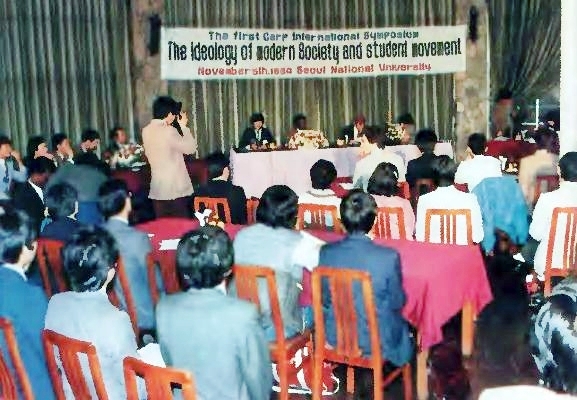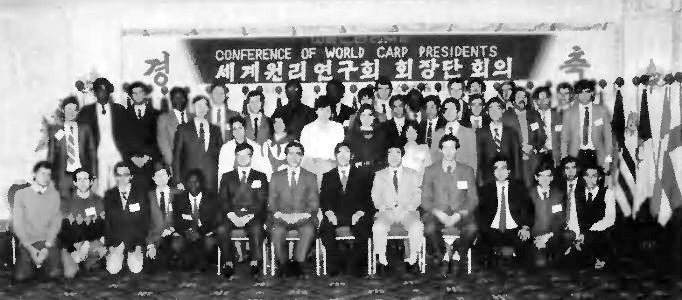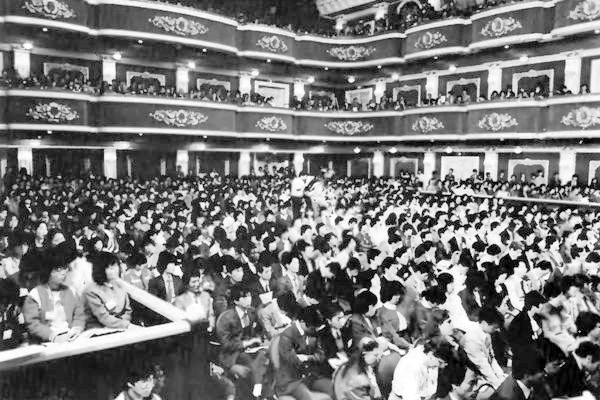![]()
The Words of the Self Family
|
|
The Words of the Self Family |

A historic advancement in the providence took place in Korea from November 2-8, 1984. The event: the first CARP Convention of World Students, with thousands of CARP students and leaders convening from over 40 nations, representing all continents. During this gathering, a number of firsts occurred. The first annual CARP World Presidents Meeting was held -- resulting in the official organization of CARP on the world level. Hyo Jin Nim, the eldest son of our True Parents, was recently appointed the first president of World CARP. As the Children's Course continues, Father has begun to ask the True Children to assume positions of great responsibility. The convention also included the formation of the first Han Ma Dang games -- the Unification movement's answer to the Olympics.
The roots of World CARP can be traced back to the original campus group that Father created on December 31, 1954, in Seoul. Father himself was the first CARP member! The precursor of CARP was the Sung Hwa Christian Student Association. Later, national CARP organizations appeared in Japan and Korea in the early 1960 s. The more immediate foundation, however, goes back to June 18, 1984. At the conclusion of a three-day meeting with national CARP presidents, Rev. Bong Tae Kim of Korea, Dr. Joon Ho Seuk of the United States and Mr. Hirokazu Ohta of Japan, Father declared June 18 to be a day of new determination and new beginning for CARP -- a day to be celebrated each year by all CARP members. At that time, he outlined his idea for the first World CARP Convention.
It is especially meaningful that CARP's leap to the international level could occur even while our True Father is in prison. Coupled with his recent honorary doctorate award from the Catholic University of La Plata in Argentina, Father's impact on both the social and educational world is expanding rapidly. From the prison, he wrote his Founder's Address to the convention.
The week-long convention included a meeting of CARP presidents, symposiums at six different universities in Seoul, the CARP Student Festival, the Han Ma Dang Olympic-style sports competition, and tours of Korea, including the DMZ, the ancient capital city of Kyongju, and the site of Father's first church in Pusan.

CARP
national presidents.
The CARP leaders of 40 nations gathered at the Little Angels School on November 3. The meeting was chaired by Rev. Bong Tae Kim, president of the Korean CARP. Rev. Kim sparked immediate excitement when he announced that Hyo Jin Nim would be the World CARP president (Hyo Jin Nim could not be present at the convention). CARP leaders recognized the significance of being able to receive direction through Father's eldest son during the Children's Course: A great blessing has been bestowed on the CARP movement.
World CARP was then formally organized in a structure similar to the United Nations, in that there would be a Council comprised of both permanent and non-permanent member nations. The four permanent members are Korea, Japan, the United States, and Germany. Eleven non-permanent members were chosen this year:
Asia -- the Philippines,
Thailand
Europe -- Britain, France, Italy
Africa -- Zaire,
Zambia
The Americas -- Canada, Brazil, Argentina
Oceania --
Australia
From 1985 on, there will be 70 non- permanent nations chosen annually. Rev. Kim announced that next year's convention would be held in Japan, with an expected 70 nations being represented, and the third convention would be in the United States in 1986, when 120 nations are projected to attend.
The rapid expansion of CARP is due largely to the enthusiastic support and drive of Rev. Chung Hwan Kwak. Rev. Kwak, who was the president of Korean CARP from 1972 to 1975, spoke to the convention at the famous Lotte Hotel on November 5. His address explained Father's situation and Father's attitude toward his incarceration, and was gratefully received.
Rev. Kim then explained about the Han Ma Dang games. Han Ma Dang means literally "One Large United Festival." Father's vision, he said, is to create a great sports competition that could someday be more famous than the Olympics and could promote world unity. Beginning with CARP, the Han Ma Dang will soon involve the whole Unification movement. Han Ma Dang athletes will train as seriously as Olympic athletes. The first Han Ma Dang would be a one-day event, said Rev. Kim, but in the future it will be a week-long competition.
Each year the Han Ma Dang Sacred Flame would be brought from Pusan, the torch being lit from the Holy Candle there and then flown by plane to Japan, then to the United States, etc. A Han Ma Dang champion's banner was given by True Parents to be awarded annually to the nation achieving an overall championship. If any nation wins this banner for three consecutive years, that nation will keep the banner and a new one will be made. The symbol of the Han Ma Dang festival was drawn by True Father in Danbury and given to Dr. Seuk to bring to Korea.
On the evening of November 3, following the Presidents Meeting, over 2,000 CARP members jammed the Little Angels School auditorium for the first International CARP Student Festival, where they were treated to over four hours of continuous entertainment from various nations.
Two CARP rock bands kept a high energy flowing. "Jae," a male vocalist very popular in Korea, was very enthusiastically received. By far the greatest performance, came from the Little Angels. Two troupes -- one composed of high school students and the other of elementary school children -- provided a dazzling display of precision, spirit, charm, and talent. As backdrop to their performance a computerized water fountain displayed breathtakingly beautiful patterns alternating with each change in the music.
The next morning all the CARP national teams, dressed in their Han Ma Dung sports outfits, gathered at the sports stadium of a local university for the much-anticipated Han Ma Dang competition. With full pageantry, the competing teams entered the noisy stadium. A full-sized marching band played as they passed before the large reviewing stand of dignitaries and lined up across the field. The stands were filled with thousands of enthusiastic fans -- both CARP members and the general public -- carrying colorful pom-poms and noisemakers. Dozens of cheerleaders urged on their favorite teams. The torchbearer entered and circled the stadium before lighting the large Han Ma Dung flame.
The first event involved all of the athletes dividing into two teams -- the Red and the Blue -- for the ancient Korean "friendship" tug of war game known as Cha Jon. Cha Jon involves all the trappings of the Crusades. Everyone wears traditional Korean uniforms. There are many flag-bearers and there are also the ladies in beautiful dresses -- all urging on their "warriors," who must carry a huge rope-covered apparatus on top of which stands their team's general and his assistant. The objective is to dethrone the opposing general.
After this warm-up, the real competitions began in volleyball, soccer, and the relay race. The Korean team had obviously prepared well. They took the soccer honors and easily won the relay race. In volleyball, the U.S. team gave the Korean team a scare. The deciding game went into overtime before Korea dominated 23-21.
At the awards ceremony, Korean CARP took all three first-place trophies as well as the championship banner. Japanese CARP took all three second- place trophies. The Han Ma Dang banner was formally turned over from Rev. Kim to Mr. Ohta, marking the beginning of preparations for the second Han Ma Dang in Japan.
The Han Ma Dang ended with hundreds of the student fans and athletes joining together for large circle-dancing and singing, covering the stadium field. A joyous spirit of celebration and brotherhood concluded the first Han Ma Dang festival.

The main work of the convention was conducted at the six student symposiums held simultaneously at different universities in Seoul. Selected students from around the world had prepared papers centering on the theme of the convention, "The Student's View of Value in Creating World Peace."
Topics for the papers included: "The Ideology of Modern Society and the Student Movement," "A New Community for a Peaceful World," and "The Role of Campus Life (University Culture) in Creating World Peace."
A question and answer session and general discussion followed the reading of the papers. Much translation was necessary in Korean, Japanese, and English.
Although the World CARP Convention resembled in many ways the United Nations, one great contrast to that organization was evident. Whereas the United Nations is often the scene of strife and division along national or bloc lines, the CARP experience was one of total harmony and open-hearted sharing. The papers were thought-provoking, and there was a common and urgent realization that we are the ones who must develop real solutions and create world peace.
In most nations, university students are at the forefront of social change. In the United States, for example, both the civil rights movement and the "peace" movements gained their power from the activities of college students. Therefore, the CARP members strove with great seriousness to understand the system of values that could usher in a new age of peace. Also common to all was the conviction that we could find the solution, chiefly because God and True Parents are with us. Rev. Bong Tae Kim expressed that in his main address to the convention:
"We are now witnessing the miracle that young people of different races, colors, and languages have gathered here under the same roof, is brothers and sisters of one family, with one purpose. This is only possible because God is with us."
Discussion after the symposiums continued over dinner and late into the night.
CARP has always stood on the front line to oppose communism through both campus and street activism and educational VOC programs. Therefore, the CARP members were especially interested in visiting the Demilitarized Zone (DMZ) which divides North and South Korea and which is itself the demarcation line between communism and democracy.
Since the Korean War ended, thousands of violations of the truce agreements have been made by the communist forces. Many times North Korean commandos have infiltrated the South. The DMZ is therefore a site of great tension. In 1978, U.S. soldiers were the victims of a brutal axe attack by North Korean soldiers at Panmunjom and two Americans were slain.
For many miles the CARP students could see strands of barbed wire, lookout towers, and mine fields. U.S. soldiers and Korean soldiers worked side by side in keeping their vigil.
The most revealing part of the visit was the tour of Tunnel Number Three -- the third and last tunnel discovered in the mid-1970s. These tunnels were dug by the North Koreans under the DMZ for the purpose of rapidly transporting large numbers of troops and equipment during a planned invasion of the South. A South Korean colonel showed the CARP members a film on the discovery of the tunnels and later led us on a tour of Tunnel Number Three. This tunnel was found after a North Korean defector described his work on the tunnel and gave the coordinates of its location. On our tour, we were shown how the North Koreans had painted the solid granite with black paint. Later in their defense they described the tunnels as old coal mines which had been dug by the Japanese during World War II. They maintained this despite the fact that the tunnels were blasted out of solid granite, in an area where no coal had ever been found!
The DMZ visit served to deepen every CARP member's determination to defeat the lies and tyranny of communism. To discuss world peace without considering the problem of communism could never be possible for the CARP students.
On the fifth day of the convention, the members left Seoul via bus to visit Kyongju and Pusan. The first stop, however, was about 45 minutes outside Seoul, at the Korean Folk Village. This village is designed so that tourists can see the "old" way of life in a country village. Everything is just as it would have been in a village circa 1850 (although some Korean villages today still retain much of the old traditional customs and ways).
There were many different industries displayed -- from mulberry paper making, to pottery production, to metal and leather works, and many other arts. A troupe of "farmers" performed traditional dances and songs. Many types of food were sold at little stands throughout the village. After an hour and a half the entourage was back on the road to Kyongju.
Arriving in Kyongju around seven p.m., the CARP students stayed in a very modern youth hostel, as they had done in Seoul. The youth hostels are convenient and inexpensive, yet provide very good accommodations.
Early the next morning, after a short bus ride, everyone climbed a small mountain to a very beautiful and famous Buddhist temple. About 500 CARP members watched breathlessly as the sun shattered the early morning darkness in a perfect sunrise. Before us spread an awe-inspiring vista: the mountain, the adjoining valley, other hills farther on, and beyond them the reflection of the rising sun in the ocean and the sun itself. The sun first appeared to be square and then became completely round. This sunrise has been aptly called "the opening of Buddha's third eye." The beauty of the moment -- with hundreds of brothers and sisters of all colors reveling in the supreme beauty of God's creation, filled many hearts with renewed certainty that one day soon the sun would rise on a peaceful, unified world.
After breakfast, the tour explored the ancient burial sites of past kings of Korea. Then, it was on to Pusan.
In Pusan, a small museum has been built around the large rock which provided the foundation for True Father's first little cardboard hut. The rock is enclosed by glass and dominates the building, which is itself a holy shrine of the Unification movement. Members knelt in prayer and many tears were shed at the realization of the great hardships our Father faced in laying the foundation of our movement. Mr. Soo Young Kim, the CARP regional leader of Pusan, spoke about Father's early days. In the museum are artifacts and photographs of that time, including the lantern by which Divine Principle was written, and one of the drawings that Rev. Won Pil Kim created as the first fundraising product over 30 years ago.
From the museum everyone hiked up the hillside to the holy ground where Father spent so much time in prayer. Here, one large stone is called the "Stone of Tears" because of the countless tears Father shed upon it. The CARP members gathered and prayed and sang "Tongil." Finally, hundreds of voices sent a clear, loud, triple cheer of "Mansei!" ringing out across all of Pusan.
Back in Seoul, a farewell banquet was planned for the evening of November 8. The American CARP members did not expect to attend because their flight was leaving at the same time. Until this point each day's weather had been perfect -- like springtime -- warm with sunny skies every day. It was as if God had truly smiled and given blessing on the first CARP international convention. To make that perfectly clear, a large fog rolled suddenly into the airport, causing all flights to be delayed two hours -- just enough time for American CARP to attend the farewell banquet! At the banquet's end, every participant was awarded a copy of Divine Principle in Hangul.
The first World CARP Convention had come to a close. From now on, there would be only World CARP members. True Parents have brought us to the universal level. May every year bring us closer to fulfilling Father's vision and hope of world peace and unity.